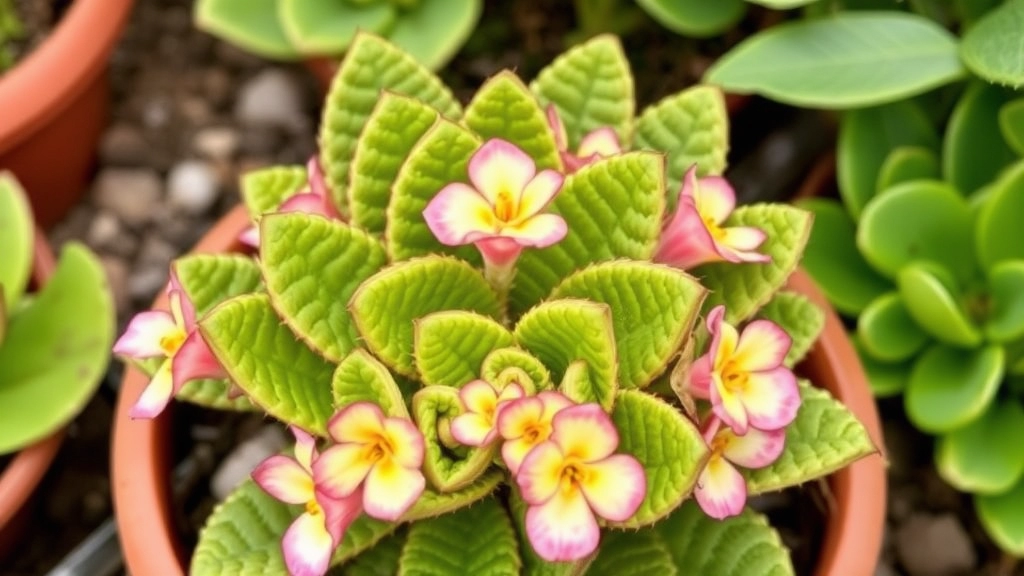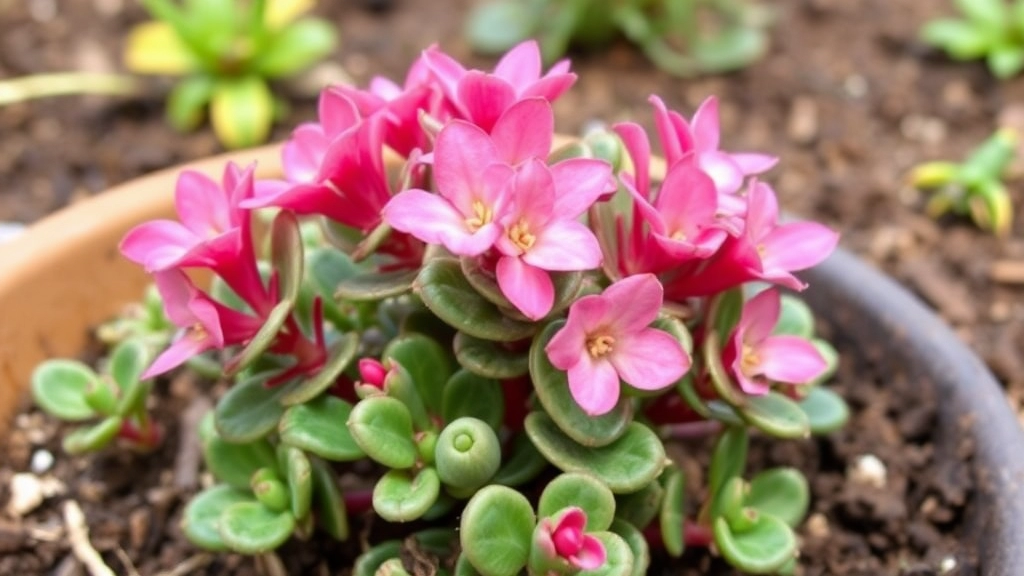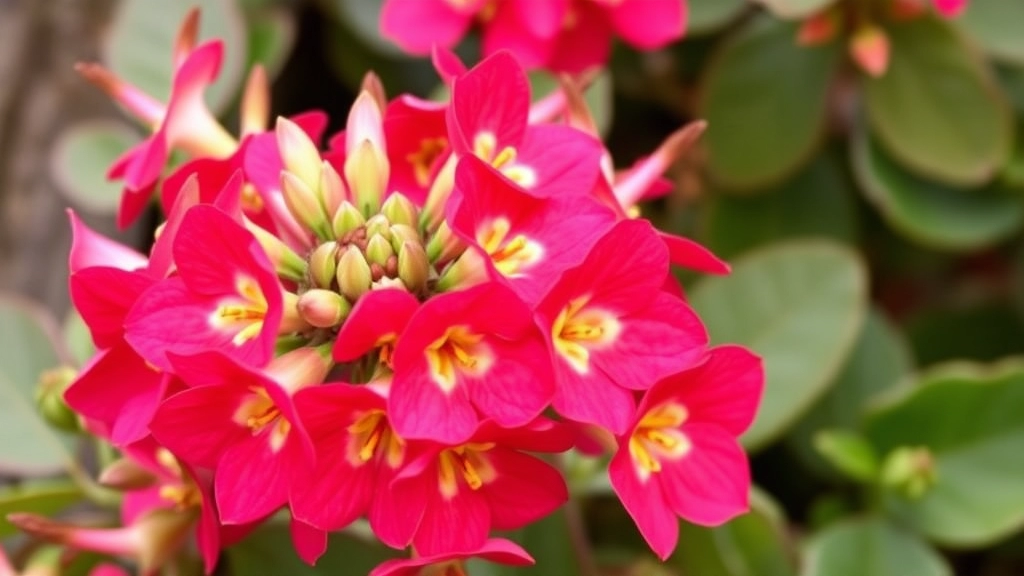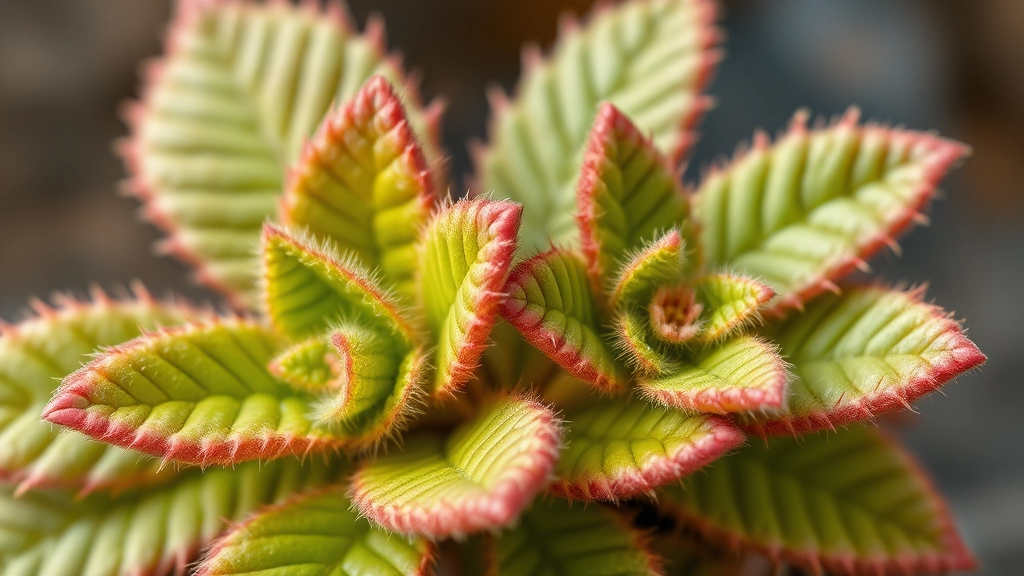Welcome to the fascinating world of Kalanchoe tomentosa
The hairy succulent that’s capturing hearts with its unique charm! In this article, we’ll explore everything you need to know about this fuzzy plant, from its distinctive characteristics to expert care tips. Get ready to discover why this velvety succulent is becoming a favorite among plant enthusiasts.
Whether you’re a seasoned gardener or a curious beginner
You’ll find valuable insights on how to nurture your Kalanchoe tomentosa. We’ll delve into its ideal growing conditions, watering needs, and propagation methods. By the end, you’ll be equipped with the knowledge to help your hairy Kalanchoe thrive and add a touch of whimsy to your plant collection.
Characteristics of Kalanchoe Tomentosa
Ever seen a plant that looks like it’s covered in fuzzy, silver fur?
That’s the Kalanchoe tomentosa, also known as the Panda Plant or Pussy Ears.
It’s a succulent that’s hard to miss and even harder not to love.
Let’s break down what makes this plant so special:
Fuzzy Leaves
The standout feature? Those velvety leaves.
They’re thick, oval-shaped, and covered in fine, silvery-white hairs.
It’s like nature’s version of a cozy blanket.
Unique Coloration
The edges of the leaves? They’re often tipped with dark brown or rust-colored spots.
It’s like each leaf has its own little chocolate dip.
Compact Growth
These plants don’t go crazy with size.
They usually stay pretty compact, perfect for small spaces or as part of a succulent collection.
Slow and Steady
Kalanchoe tomentosa isn’t in a rush.
It grows slowly, which means less maintenance for you.
Win-win, right?
Drought Tolerance
Like most succulents, it’s a champ at handling dry spells.
Forgot to water it for a bit? No worries, it’ll forgive you.
Rare Blooms
While it’s mainly grown for its foliage, it can surprise you with small, yellow-green flowers.
But don’t hold your breath – blooms are pretty rare in indoor plants.
The Kalanchoe tomentosa is a real character in the plant world.
Its fuzzy leaves and unique look make it a standout in any collection.
Whether you’re a plant newbie or a seasoned green thumb, this little guy is sure to catch your eye and steal your heart.
Growing Conditions for Kalanchoe Tomentosa

Alright, let’s chat about growing Kalanchoe Tomentosa, or as I like to call it, the “Panda Plant.” Trust me, once you get the hang of it, it’s a breeze.
First things first, these succulents are tough cookies. They’re not fussy, which is perfect if you’re like me and sometimes forget you even have plants. Here’s the lowdown on what they need:
Temperature:
- These guys love it warm. Think 60-75°F (15-24°C).
- Can handle a bit of cold, but don’t let it freeze.
Humidity:
- Not picky at all. Average room humidity is fine.
- Actually prefer it on the drier side.
Airflow:
- Good circulation is key.
- No stuffy corners for this plant!
Now, here’s a pro tip: Kalanchoe Tomentosa is perfect for that sunny windowsill you’ve been trying to fill. They’re compact and won’t take over your space.
But here’s the thing â and I learned this the hard way â don’t coddle them. These plants thrive on a bit of neglect. Seriously, the less you fuss, the happier they’ll be.
Remember, Kalanchoe Tomentosa is a succulent. That means it’s built to store water and survive in tough conditions. So, if you’re worried about being a “plant killer,” this might just be your new best friend.
In my experience, the key to success with Kalanchoe Tomentosa is mimicking its natural habitat. Think dry, warm, and bright. Get those conditions right, and you’ll have a happy, fuzzy little plant that’s practically indestructible.
So, ready to give it a go? Trust me, once you nail these growing conditions, your Kalanchoe Tomentosa will be thriving in no time.
Watering Needs of Kalanchoe Tomentosa
Ever wondered how often to water your Panda Plant? Let’s dive in.
Kalanchoe tomentosa, aka the Panda Plant, is a thirsty little fella, but not too thirsty.
Here’s the deal:
- Water when the soil’s dry to the touch
- Stick your finger in about an inch deep – if it’s dry, it’s time to water
- During growing season (spring and summer), water every 1-2 weeks
- In winter, cut back to once every 3-4 weeks
But here’s the kicker:
Overwatering is a bigger problem than underwatering.
These succulents store water in their leaves, so they can handle a bit of drought.
Soggy soil? That’s a no-go. It’ll lead to root rot faster than you can say “Kalanchoe”.
Pro tip: Use the “soak and dry” method.
Water thoroughly until it runs out the drainage holes, then let it dry out completely.
Got a Panda Plant in a pot without drainage? That’s asking for trouble, mate.
Always use pots with drainage holes to avoid water pooling at the bottom.
Remember:
Kalanchoe tomentosa is drought-tolerant, so when in doubt, err on the side of underwatering.
Your Panda Plant will thank you for it.
Soil Requirements for Kalanchoe Tomentosa

Let’s talk soil, folks. Kalanchoe tomentosa, our fuzzy little friend, isn’t too picky about its dirt, but it does have some preferences. Trust me, I’ve learned this the hard way.
Here’s the deal:
- Well-draining soil is key
- A mix of regular potting soil and sand or perlite works wonders
- Aim for a pH between 6.0 and 7.5
Now, you might be thinking, “Why all the fuss about drainage?” Well, let me tell you a quick story. I once planted a Kalanchoe in regular garden soil, thinking it’d be fine. Big mistake. The poor thing nearly drowned! Its roots were sitting in water, and it started to look pretty sad.
So, here’s what I do now:
- I grab a bag of cactus or succulent mix from the garden centre
- I mix in some extra perlite or coarse sand (about 1 part to 3 parts soil)
- I make sure the pot has drainage holes (crucial!)
This setup mimics the Kalanchoe’s natural habitat. Remember, these guys are used to growing in rocky, sandy soils where water doesn’t hang around.
But here’s a pro tip: don’t go overboard with the sand. Too much, and you’ll end up with soil that dries out faster than you can say “Kalanchoe tomentosa”!
Now, about that pH level. Most commercial potting mixes fall within the right range, so you probably don’t need to worry about it. But if you’re a bit of a soil nerd (no judgement here!), you can grab a pH testing kit and check.
Bottom line: Kalanchoe tomentosa likes its soil like I like my bank account – not too rich, but with good drainage! If you’re interested in learning more about different varieties, check out our guide on types of Kalanchoe tomentosa.
Light Preferences for Kalanchoe Tomentosa
Let’s chat about the light preferences of Kalanchoe Tomentosa, aka the Panda Plant.
These fuzzy little succulents are pretty chill when it comes to light.
But they do have their sweet spots.
Bright, indirect light is their jam.
Think of it like this: they want to be at the beach, but under an umbrella.
Too much direct sun? That’s a no-go. It’ll scorch their leaves faster than you can say “sunburn”.
Not enough light? They’ll get leggy and sad. Nobody wants a sad panda plant.
Here’s the deal:
- Indoors: Pop them near a bright window, but not right on the sill
- Outdoors: Find a spot with morning sun and afternoon shade
- Artificial light: They can handle it, but they prefer the real deal
Pro tip: If your Kalanchoe’s leaves are turning yellow, it might be getting too much sun.
On the flip side, if it’s stretching out like it’s reaching for something, it needs more light.
Remember, these plants are native to Madagascar. They’re used to bright, but filtered light.
So, think tropical, not desert.
Getting the light right is key to keeping your Kalanchoe Tomentosa happy and healthy.
It’s all about finding that sweet spot between too much and too little.
Kalanchoe tomentosa, also known as the “teddy bear” plant, is a charming succulent that’s relatively easy to care for. However, like all plants, it can face some challenges. Common pests that may affect your Kalanchoe tomentosa include mealybugs, spider mites, and scale insects. These pests can be managed with regular inspection and appropriate treatments.
In terms of diseases, Kalanchoe tomentosa is most susceptible to root rot, which is often caused by overwatering. To prevent this, ensure your plant is in well-draining soil and only water when the soil is completely dry. Powdery mildew and leaf spot can also occur, especially in humid conditions or when water sits on the leaves.
To keep your Kalanchoe tomentosa healthy, provide it with bright, indirect light, and maintain good air circulation around the plant. Regular inspection for pests and proper watering habits will go a long way in preventing most issues. If you do encounter problems, early detection and treatment are key to maintaining the health and beauty of your teddy bear plant.
Propagation Methods for Kalanchoe Tomentosa
Ever wondered how to get more of these fuzzy succulents without breaking the bank?
Let’s dive into propagating Kalanchoe tomentosa, aka the Panda Plant.
Here’s the deal: it’s actually pretty simple.
Leaf Cuttings:
- Gently twist off a healthy leaf
- Let it dry for a day or two
- Pop it on some well-draining soil
- Mist occasionally
- Watch for tiny roots and leaves to sprout
Stem Cuttings:
- Snip a 3-4 inch stem
- Remove lower leaves
- Let it callous over for a day
- Stick it in succulent soil
- Keep it slightly moist
Seeds:
- Not the easiest, but doable
- Sow on top of soil
- Keep warm and lightly moist
- Patience is key – they’re slow growers
Pro tip: Spring and summer are prime time for propagation.
Remember, Kalanchoe tomentosa likes it warm and bright.
Don’t overwater – these guys are drought-tolerant.
Got more than you bargained for? Share with friends or expand your indoor jungle.
Propagating Kalanchoe tomentosa is a fun way to multiply your plant collection on the cheap.
Seasonal Care Tips for Kalanchoe Tomentosa

Let’s chat about keeping your Kalanchoe tomentosa happy all year round. These fuzzy little succulents aren’t too high-maintenance, but they do appreciate a bit of TLC as the seasons change.
Spring: Wakey-Wakey!
- Time to shake off that winter slumber
- Gradually increase watering as growth picks up
- Give it a light feed with a balanced, water-soluble fertiliser
Summer: Livin’ Easy
- Water more frequently, but don’t go overboard
- Move to a spot with bright, indirect light if it’s scorching outside
- Watch out for sunburn on those velvety leaves
Autumn: Winding Down
- Ease off on the watering as growth slows
- Stop fertilising â your Kalanchoe’s going into chill mode
- Bring it indoors if you live somewhere chilly
Winter: Snooze Time
- Water sparingly â just enough to keep it from shrivelling
- Find a cosy spot away from cold drafts and radiators
- Hold off on repotting or pruning until spring
Pro Tip: Keep an eye on your Kalanchoe tomentosa’s leaves. They’ll tell you if something’s off. Droopy? Might need a drink. Yellow? Ease up on the water. Brown and crispy? It’s probably sunburnt.
Remember, these are just guidelines. Your Kalanchoe might march to its own beat depending on where you live. The key is to pay attention and adjust as needed. It’s not rocket science â just a bit of plant parenting.
So, there you have it â your year-round guide to keeping your Kalanchoe tomentosa thriving. With these seasonal care tips, you’ll be well on your way to becoming a Kalanchoe whisperer. Just keep an eye on those fuzzy leaves, and you’ll do fine! If you’re interested in exploring different varieties, check out our guide on types of Kalanchoe tomentosa.
Decorative Uses of Kalanchoe Tomentosa in Home and Garden
Kalanchoe tomentosa, aka the Panda Plant, is a total game-changer for spicing up your space.
Let’s dive into how this fuzzy little succulent can transform your home and garden:
1. Indoor Decor Superstar
- Pop it on your desk for a touch of green that doesn’t need babysitting
- Group it with other succulents for a mini desert vibe
- Use it as a quirky bookend – it’s sturdy enough to handle the job
2. Outdoor Charm
- Plant it in rock gardens for a soft contrast to hard edges
- Let it cascade over the sides of hanging baskets
- Use it as a ground cover in dry, sunny spots
3. Conversation Starter
The Panda Plant’s unique fuzzy leaves are a natural ice-breaker.
Stick it somewhere visible and watch your guests go “What’s that?”
4. Low-Maintenance Centerpiece
Need a table centerpiece that won’t die if you forget about it?
Kalanchoe tomentosa’s got your back.
5. Gift That Keeps on Giving
- Perfect for housewarming presents
- Great for office mates who can’t keep plants alive
- Ideal for kids learning about plant care
6. Texture Play
Mix it with smooth-leaved plants for a tactile garden experience.
7. Space Saver
Its compact size makes it perfect for small apartments or tight corners.
Remember, Kalanchoe tomentosa isn’t just a plant – it’s a versatile decor piece that can breathe life into any space.
Get creative, have fun, and let this fuzzy friend work its magic in your home and garden.
Troubleshooting Common Problems with Kalanchoe Tomentosa
Let’s dive into the nitty-gritty of Kalanchoe tomentosa troubles. I’ve seen my fair share of plant drama, and this fuzzy little succulent isn’t immune to its own set of hiccups.
Common Kalanchoe Conundrums:
1. Droopy Leaves: What’s the Deal?
- Overwatering is usually the culprit
- Underwatering can cause this too (I know, it’s confusing!)
- Root rot might be lurking beneath the soil
Quick Fix: Ease up on the watering, check for root health, and adjust your schedule.
2. Leaf Discoloration: Why So Yellow?
- Too much sun can bleach those fuzzy leaves
- Not enough light can make them pale and sad
- Nutrient deficiencies might be at play
Solution: Find that Goldilocks spot for light and consider a gentle fertilizer boost.
3. Leggy Growth: Stretching for the Stars?
- Insufficient light is the main suspect here
- Your plant’s basically reaching out for more sunshine
Remedy: Relocate to a brighter spot or introduce some grow lights to the mix.
4. Pest Invasion: Unwanted Guests?
- Mealybugs love to crash the Kalanchoe party
- Spider mites might decide to set up shop
Battle Plan: Isolate the plant, use neem oil or insecticidal soap, and keep an eagle eye out for repeat offenders.
5. Leaf Drop: Why the Naked Look?
- Stress from temperature changes
- Overwatering can cause this too
- Sometimes it’s just old leaves making way for new growth
Action Steps: Stabilize the environment, adjust watering, and don’t panic if it’s just natural shedding.
Remember, Kalanchoe tomentosa is pretty forgiving. Most issues can be sorted with a bit of TLC and some plant detective work. Keep an eye on your fuzzy friend, and you’ll catch problems before they spiral out of control.
Pro Tip: When in doubt, less is often more with these succulents. They’re tough cookies that prefer a bit of neglect to helicopter plant parenting.
Troubleshooting Kalanchoe tomentosa doesn’t have to be a headache. With these tips in your back pocket, you’re well-equipped to tackle any issues that pop up. Happy growing!
FAQs about Kalanchoe Tomentosa
1. What makes Kalanchoe tomentosa unique?
Kalanchoe tomentosa, also known as the Panda Plant or Pussy Ears, is characterized by its thick, oval-shaped leaves covered in fine, silvery-white hairs. This fuzzy texture gives it a unique, velvety appearance that sets it apart from other succulents.
2. How often should I water my Kalanchoe tomentosa?
Water your Kalanchoe tomentosa when the soil is completely dry. During the growing season (spring and summer), this might be every 1-2 weeks. In winter, reduce watering to once every 3-4 weeks. Remember, it’s better to underwater than overwater this drought-tolerant plant.
3. What type of soil does Kalanchoe tomentosa prefer?
Kalanchoe tomentosa thrives in well-draining soil. A mix of regular potting soil with sand or perlite works well. Aim for a soil pH between 6.0 and 7.5. Always use pots with drainage holes to prevent water from pooling at the bottom.
4. How much light does Kalanchoe tomentosa need?
These plants prefer bright, indirect light. Too much direct sun can scorch the leaves, while too little light can cause leggy growth. A spot near a bright window, but not directly on the sill, is ideal for indoor plants.
5. How can I propagate my Kalanchoe tomentosa?
Kalanchoe tomentosa can be propagated through leaf cuttings, stem cuttings, or seeds. The easiest method is leaf propagation: gently remove a healthy leaf, let it callous for a day or two, then place it on well-draining soil and mist occasionally until roots develop.
6. Is Kalanchoe tomentosa pet-friendly?
Unfortunately, Kalanchoe tomentosa is toxic to pets if ingested. It’s best to keep this plant out of reach of curious cats and dogs.
7. How can I use Kalanchoe tomentosa in home decor?
Kalanchoe tomentosa is versatile in home decor. It works well as a desk plant, in succulent arrangements, or as part of a rock garden. Its compact size and unique texture make it a great conversation piece in any room.
8. How do I know if my Kalanchoe tomentosa is healthy?
A healthy Kalanchoe tomentosa will have firm, plump leaves with a fuzzy texture. The plant should maintain its compact shape without excessive stretching. If the leaves start to yellow, brown, or drop, it may indicate a problem with watering or light.
References
-
Missouri Botanical Garden – Kalanchoe tomentosa Plant Finder: Kalanchoe tomentosa

